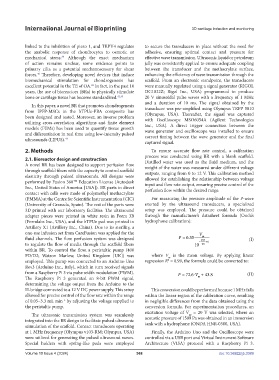Page 376 - IJB-10-4
P. 376
International Journal of Bioprinting 3D cartilage induction and monitoring
linked to the inhibition of piezo 1, and TRPV4 regulates to secure the transducers in place without the need for
the anabolic response of chondrocytes to osmotic or adhesive, ensuring optimal contact and pressure for
mechanical stress. Although the exact mechanism effective wave transmission. Ultrasonic liquid or petroleum
39
of action remains unclear, some evidence points to jelly was consistently applied to ensure adequate coupling
primary cilia as a potential mechanosensory for shear between the transducer and the methacrylate surface,
forces. Therefore, developing novel devices that induce enhancing the efficiency of wave transmission through the
40
biomechanical stimulation for chondrogenesis has scaffold. From an electronic standpoint, the transducers
excellent potential in the TE of OA. In fact, in the past 10 were manually regulated using a signal generator (RIGOL
41
years, the use of bioreactors (BRs) to physically stimulate DG1022Z; Rigol Inc., USA) programmed to produce
bone or cartilage tissue has become standardized. 42,43 20 V sinusoidal pulse waves with a frequency of 1 MHz
and a duration of 10 ms. The signal obtained by the
In this paper, a novel BR that promotes chondrogenesis
from IPFP-MSCs in the bTPUe-PBA composite has transducer was pre-amplified using Olympus TRPP 5810
(Olympus, USA). Thereafter, the signal was captured
been designed and tested. Moreover, an inverse problem with Oscilloscope MSO6054A (Agilent Technologies
utilizing cross-correlation algorithms and finite element Inc., USA). A direct trigger connection between the
models (FEMs) has been used to quantify tissue growth wave generator and oscilloscope was installed to ensure
and differentiation in real time using low-intensity pulsed correct timing between the wave generator and the final
ultrasounds (LIPUS).
44
captured signal.
2. Methods To ensure accurate flow rate control, a calibration
process was conducted using BR with a blank scaffold.
2.1. Bioreactor design and construction Distilled water was used as the fluid medium, and the
A novel BR has been designed to support perfusion flow weight of the water was measured under different voltage
through scaffold fibers with the capacity to control scaffold outputs, ranging from 0 to 12 V. This calibration method
elasticity through pulsed ultrasounds. All designs were allowed for establishing the relationship between voltage
performed by Fusion 360 Education License (Autodesk input and flow rate output, ensuring precise control of the
TM
Inc., United States of America [USA]). BR parts in direct perfusion flow within the desired range.
contact with cells were made of polymethyl methacrylate
(PMMA) at the Centre for Scientific Instrumentation (CIC) For measuring the pressure amplitude of the P-wave
(University of Granada, Spain). The rest of the parts were exerted by the ultrasound transducers, a specialized
3D printed with our laboratory facilities. The ultrasound setup was employed. The pressure could be obtained
adapter pieces were printed in white resin in Form 3B through the manufacturer’s datasheet formula (Onda’s
(Formlabs Inc., USA), and the bTPUe pad was printed in hydrophone calibration):
Artillery X1 (Artillery Inc., China). Due to its sterility, a
one-use infusion set from CareFusion was applied for the V
m
fluid channels. The flow perfusion system was designed P = 035. 254 (I)
to regulate the flow of media through the scaffold fibers 10 − 20 +6
within BR. To control the flow, a peristaltic pump (400
FD/D2; Watson Marlow, United Kingdom [UK]) was where V is the mean voltage. By applying linear
m
employed. This pump was connected to an Arduino Uno regression R = 0.99, the formula could be converted to:
2
Rev3 (Arduino Inc., Italy), which in turn received signals
from a Raspberry Pi 3 via pulse width modulation (PWM). P = 72 6. V ⋅ + 438. (II)
The Raspberry Pi 3 generated an 8-bit PWM signal, m
determining the voltage output from the Arduino to the
H-bridge connected to a 12 V DC power supply. This setup This conversion could be performed because 1 MHz falls
allowed for precise control of the flow rate within the range within the linear region of the calibration curve, resulting
of 0.05–3.3 mL min by adjusting the voltage supplied to in negligible differences from the data obtained using the
−1
the peristaltic pump. conversion formula. For experimentation procedures, an
excitation voltage of V = 20 V was selected, where an
The ultrasonic transmission system was seamlessly pp
integrated into the BR design to facilitate pulsed ultrasonic acoustic pressure of 1509 Pa was obtained in an immersion
tank with a hydrophone (ONDA HNR-0500, USA).
stimulation of the scaffold. Contact transducers operating
at 1 MHz frequency (Olympus v103-RM; Olympus, USA) Finally, the Arduino Uno and the Oscilloscope were
were utilized for generating the pulsed ultrasound waves. controlled via a USB port and Virtual Instrument Software
Special holders with spring-like pads were employed Architecture (VISA) protocol with a Raspberry Pi 3.
Volume 10 Issue 4 (2024) 368 doi: 10.36922/ijb.3389

